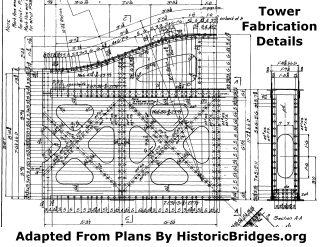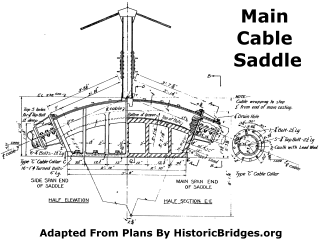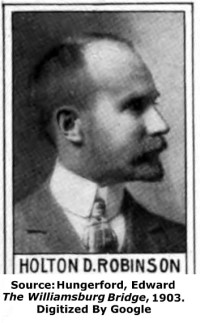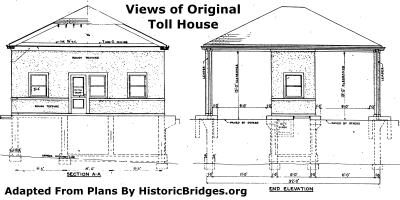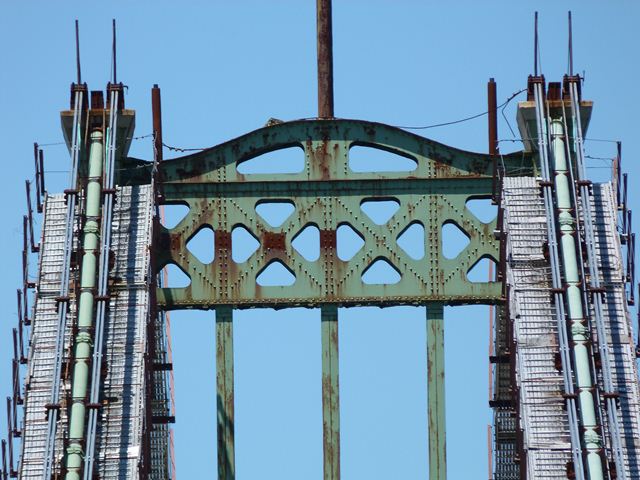We Recommend:
Bach Steel - Experts at historic truss bridge restoration.
BridgeHunter.com Phase 1 is released to the public! - Visit Now
Waldo-Hancock Bridge
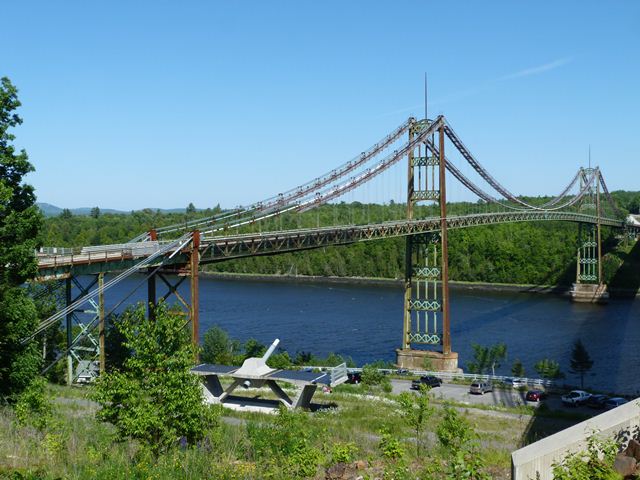
Primary Photographer(s): Nathan Holth
Bridge Documented: June 17, 2012
Bucksport: Hancock County, Maine and Waldo County, Maine: United States
Metal Pony Truss Stiffening Wire Cable Suspension, Fixed and Approach Spans: Metal Deck Girder, Fixed
1931 By Builder/Contractor: American Bridge Company of New York, New York and Engineer/Design: Robinson and Steinman of New York, New York
2003
800.0 Feet (243.8 Meters)
2,042.0 Feet (622.4 Meters)
23 Feet (7.01 Meters)
3 Main Span(s) and 9 Approach Span(s)
3008

View Information About HSR Ratings
Bridge Documentation
This bridge no longer exists!
View Archived National Bridge Inventory Report - Has Additional Details and Evaluation
View Historic American Engineering Record (HAER) Documentation For This Bridge
HAER Data Pages, PDF
View Historical Article About This Bridge
View The Maine Historic Preservation Commission Form For This Bridge
Download The Original Plans For This Historic Bridge
View A Biography of David B. Steinman
This highly significant historic bridge that was not in the way of anything was demolished by MaineDOT in 2013!
About This Bridge
This bridge represents an outstanding example of a large-span suspension bridge designed by David B. Steinman of the firm Robinson and Steinman. David Steinman is worthy of being recognized as one of the greatest suspension bridge engineers in the 20th Century. The Waldo-Hancock Bridge displays details associated with other Steinman suspension bridges. In particular the design of the tower, with its heavy lattice pattern is something found on a number of bridges designed by Steinman. The parallel vertical beams running between the lattice, forming a vierendeel truss, are much more unusual, but are shared with Maine's Deer Isle Bridge, the only other Steinman bridge in the state. The design of the main cable includes a detail where the cable rests on a saddle at cable bents at the extreme ends of the suspended spans. Here, the curve of the cable ends and the cable then proceeds directly down at a straight angle to the anchorage, a detail also found in Steinman's Mackinac Bridge. Other bridges may feature this design, but it is often hidden by massive anchorages.
The Waldo-Hancock Bridge also has several unique details. The towers of the bridge feature an attractive curved detail at the top. Additionally, at the center of the top of the towers, a pointed rod rises up a significant distance into the air. These rods are an original detail, outlined on the original bridge plans. The anchorages for the Waldo-Hancock are small, compared to other suspension bridges of this size. The bridge is also unusual compared to most suspension bridges in the United States because the roadway is positioned well more than halfway up the height of the towers, meaning that a majority of the tower height is located below the deck. This design gives the bridge a unique appearance among suspension bridges.
The bridge, as documented by HistoricBridges.org in 2012, contained some alterations. In particular, supplemental main cables were added to the bridge, located above the path of the original main cables. The supplemental main cables tie into their own new anchorages, separate of the original anchorages. These alterations date to the emergency repairs made in the early 2000s. A much older alteration appears to have been the widening of the western entrance to the bridge. Some welded girders were added to add width to the roadway originally provided by the riveted deck girders, and the abutment was widened to accommodate this widening as well. This alteration essentially created a flared appearance at the western end of the bridge. Aside from these alterations, the overall bridge retained integrity of original design. Towers and stiffening trusses appeared to be largely unaltered. The deck plate girder approach spans and supporting bents appeared to be largely unaltered. Railings on the bridge appeared to be original.
This bridge was listed on the National Register of Historic Places. It also was on the highly exclusive list of National Historic Civil Engineering Landmarks, a rare distinction of which very few bridges are given.
Neglect and Ignorance

MaineDOT began a project to rehabilitate this historic bridge in 2000, however by 2002, MaineDOT claimed that the bridge was beyond repair. At that point, they began construction on a cable stayed bridge replacement on a new, nearby alignment. Following completion of the cable-stayed bridge in 2007, the bridge was left standing next to its replacement until 2012, when the demolition of the bridge was begun and completed in 2013.
By demolishing this bridge, Maine gained the dubious distinction of being the first to demolish a bridge that was designated as a National Historic Civil Engineering Landmark (NHCL). Based on a review of the few bridges designated as NHCLs since the program began in 1964, the only bridges on the list no longer extant today were destroyed by natural disaster. This is likely because most owners of an NHCL listed bridge realize that such bridges are extremely significant and should be preserved at all costs.
It would take a unique combination of severe neglect and ignorance to allow a suspension bridge designed by David B. Steinman to deteriorate to a point beyond repair. Ignorance because any owner of such a bridge should be aware of the extremely high historic significance of a Steinman suspension bridge and the importance of preserving it. While David Steinman can be regarded as being among the greatest bridge engineers in the United States, the total number of existing bridges associated with him is relatively small, perhaps because he devoted much of his efforts to working on large bridges that took many years to design and see to completion. This small number of surviving bridges, combined with engineering significance associated with these bridges should make the preservation of each surviving example the highest priority. Furthermore, anyone with even a basic knowledge of who David Steinman was, would know that bridges designed by Steinman are nothing but the best of bridges. Not only would it take an incredible amount of neglect and deferred maintenance to allow one of Steinman's suspension bridges (all of which date to the 20th Century) to deteriorate to a point "beyond repair," to do so would represent an enormous waste of tax dollars. Having to construct a new bridge is always extremely expensive, and worse, it is an unfortunate reality that bridges built after Steinman's time have failed to show a durability and quality of construction that would suggest that a replacement bridge could hope to offer a fraction of the potential service life of a Steinman suspension bridge.
It extremely unfortunate that Maine did indeed allow the Waldo-Hancock Bridge to deteriorate to the point that it could not handle legal vehicular loads. However, upon completion of the replacement cable-stayed bridge which was built on a new alignment south of the historic bridge, Maine did at first appear to be "taking the high road" by not demolishing the historic bridge and choosing to leave it standing. Maine fenced it off to both pedestrians and vehicles, however it remained standing for visitors to view. Additionally, in this condition, there was always a chance to rehabilitate the bridge for pedestrian use. Instead, Maine opted to take a bad situation and make it worse by making plans to demolish the bridge in Fall 2012. This demolition is a complete waste of tax dollars and of history. The bridge is not in the way of any replacement structure. Additionally, the bridge is one of the main sights to be seen from the Penobscot Narrows Bridge Observatory, located at the top of the replacement bridge's western tower.
It should be noted that the replacement cable-stayed bridge fails to provide any additional traffic capacity. Although the replacement bridge has very wide shoulders, the bridge remains a two-lane structure, the same as the historic bridge. Additionally, the replacement bridge does not provide any sidewalks for pedestrians. Given this design, it is clear that the rehabilitation of the historic bridge for pedestrian use would have been more than just preservation... it would have shown a commitment in Maine to alternative transportation, a commitment that is not demonstrated in the replacement bridge.
One thing worth noting is that the Waldo-Hancock Bridge was originally a toll bridge. Original plans for the bridge show the design of the toll house. It is unclear why Maine allowed this well-built and significant historic bridge to deteriorate. However, the truth is that at some point the bridge ceased to be a toll bridge. Perhaps this was a poor choice on Maine's part. While Maine sees fit to charge travelers for the privilege of driving on I-95, it apparently never considered paying for the bridge's maintenance by continuing the practice of having a small bridge toll. The state of Michigan maintains the Mackinac Bridge, one of the largest suspension bridges in the world (and also a product of David Steinman) solely through the use of bridge tolls. The Benjamin Franklin Bridge is another example of a large suspension bridge, and one of an age closer to that of the Waldo Hancock, that has been kept in pristine condition with the assistance of tolls.
In summary, Maine failed numerous times with this bridge, choosing to ignore repeated opportunities for preservation. Maine first failed to maintain the bridge for vehicular use. Maine then failed to rehabilitate the bridge for pedestrian use. Maine also failed to simply leave the bridge standing, abandoned, for its historic value. Maine even failed to leave just the towers standing for their historic value. Every opportunity for preservation was dismissed.
|
Main Plaque WALDO-HANCOCK BRIDGESTATE OF MAINE WILLIAM TUDOR GARDINER - GOVERNOR DIRECTORS OF WALDO-HANCOCK BRIDGE FRANK A. PEABODY - CHAIRMAN
ROBINSON AND STEINMAN - ENGINEERS C. H. GRONQUIST - RESIDENT ENGINEER CONTRACTORS AMERICAN BRIDGE COMPANY MERRITT-CHAPMAN & SCOTT CORPORATION 1931 |
Information and Findings From Maine's Historic Bridge InventoryDiscussion of Bridge The 1931 suspension bridge designed by David B. Steinman, one of America's great 20th century consulting engineers, was listed in the National Register of Historic Places in 1985, and it was designated a national ASCE landmark in 2002. It was recorded by HAER (ME-65). It is one of a series of major suspension bridges designed by Steinman from the late 1920s through the 1950s. Although not among his longest suspension bridges, it is noteworthy particularly for its towers, which combine the innovative Vierendeel truss (absence of diagonals) with a successful attempt to arrange the spacing and proportions of the members for the aesthetic effect Steinman desired. The bridge wire cables are prestressed and prefabricated, which eliminated the time-consuming process of spinning the cables in place. The three main spans of the 12-span bridge are suspended; the 800' long main span between the towers and the 350' approach spans. This bridge and the 1931 St. Johns Bridge at Portland, OR are Steinman's earliest, major suspension bridges. He would later design the Deer Isle-Sedgwick bridge in Maine in 1939. As one of two, complete "modern" suspension bridges in the state, the Waldo-Hancock Bridge is considered a rare example of its type and design and thus has a high preservation priority. Of the two Steinman suspension bridges in the state, this is the one with the greater technological significance as it represents the early application of Steinman's design theories. Bridge Considered Historic By Survey: Yes |
![]()
Photo Galleries and Videos: Waldo-Hancock Bridge
Structure Overview
Original / Full Size PhotosA collection of overview photos that show the bridge as a whole and general areas of the bridge. This gallery offers photos in the highest available resolution and file size in a touch-friendly popup viewer.
Alternatively, Browse Without Using Viewer
![]()
Structure Details
Original / Full Size PhotosA collection of detail photos that document the parts, construction, and condition of the bridge. This gallery offers photos in the highest available resolution and file size in a touch-friendly popup viewer.
Alternatively, Browse Without Using Viewer
![]()
Structure Overview
Mobile Optimized PhotosA collection of overview photos that show the bridge as a whole and general areas of the bridge. This gallery features data-friendly, fast-loading photos in a touch-friendly popup viewer.
Alternatively, Browse Without Using Viewer
![]()
Structure Details
Mobile Optimized PhotosA collection of detail photos that document the parts, construction, and condition of the bridge. This gallery features data-friendly, fast-loading photos in a touch-friendly popup viewer.
Alternatively, Browse Without Using Viewer
![]()
Maps and Links: Waldo-Hancock Bridge
This historic bridge has been demolished. This map is shown for reference purposes only.
Coordinates (Latitude, Longitude):
Search For Additional Bridge Listings:
Bridgehunter.com: View listed bridges within 0.5 miles (0.8 kilometers) of this bridge.
Bridgehunter.com: View listed bridges within 10 miles (16 kilometers) of this bridge.
Additional Maps:
Google Streetview (If Available)
GeoHack (Additional Links and Coordinates)
Apple Maps (Via DuckDuckGo Search)
Apple Maps (Apple devices only)
Android: Open Location In Your Map or GPS App
Flickr Gallery (Find Nearby Photos)
Wikimedia Commons (Find Nearby Photos)
Directions Via Sygic For Android
Directions Via Sygic For iOS and Android Dolphin Browser
USGS National Map (United States Only)
Historical USGS Topo Maps (United States Only)
Historic Aerials (United States Only)
CalTopo Maps (United States Only)


